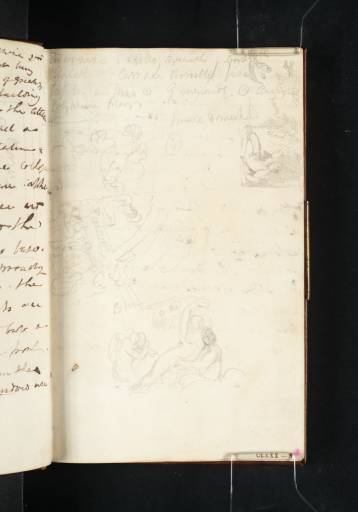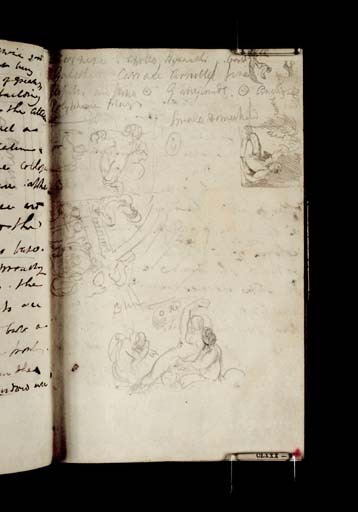Joseph Mallord William Turner Notes and Sketches relating to the Farnese Gallery, Palazzo Farnese, Rome 1819
Image 1 of 2
Joseph Mallord William Turner,
Notes and Sketches relating to the Farnese Gallery, Palazzo Farnese, Rome
1819
Joseph Mallord William Turner 1775–1851
Folio 3 Recto:
Notes and Sketches relating to the Farnese Gallery, Palazzo Farnese, Rome 1819
D15109
Turner Bequest CLXXX 3
Turner Bequest CLXXX 3
Pencil on white wove paper, 161 x 101 mm
Inscribed by the artist in pencil ‘Farnese. Apollo Hyacinthus bad | Galatea Carraci Annible fine | Jupiter and Juno .[encircled] Ganymede. [circle] Anchises | Polypheme playing | small Domechino’ across top and ‘Blue’ and ‘Red’ within sketch at bottom
Inscribed by John Ruskin in red ink ‘3’ bottom right
Stamped in black ‘CLXXX 3’ bottom right
Inscribed by John Ruskin in red ink ‘3’ bottom right
Stamped in black ‘CLXXX 3’ bottom right
Accepted by the nation as part of the Turner Bequest 1856
References
1909
A.J. Finberg, A Complete Inventory of the Drawings of the Turner Bequest, London 1909, vol.I, p.531, as ‘Slight sketches of Annibale Carracci “Galatea” in the Palazzo Farnese, and other figures; also – “Farnese. Apollo, ... bad Galatea. Carracci Annibale fine. Jupiter & Juno. Ganymede, Anchises, Polypheme playing. Small Domenichino’.
1984
Cecilia Powell, ‘Turner on Classic Ground: His Visits to Central and Southern Italy and Related Paintings and Drawings’, unpublished Ph.D thesis, Courtauld Institute of Art, University of London 1984, p.151 note 2, 152 notes 7 and 8, 412, as ‘These include sketches of Daedulus and Icarus; a corner of the ceiling; Glaucus and Scylla’.
1987
Cecilia Powell, Turner in the South: Rome, Naples, Florence, New Haven and London 1987, p.65 (notes 1, 3 and 4).
2008
James Hamilton, Nicola Moorby, Christopher Baker and others, Turner e l’Italia, exhibition catalogue, Palazzo dei Diamanti, Ferrara 2008, pp.49, 91 (note 66).
2009
James Hamilton, Nicola Moorby, Christopher Baker and others, Turner & Italy, exhibition catalogue, National Galleries of Scotland, Edinburgh 2009, pp.49, 151 (note 66).
As Finberg first identified, the notes and sketches on this page refer to frescoes in the Palazzo Farnese, specifically the Farnese Gallery’s Loves of the Gods cycle, 1597–1604, by Annibale Carracci (1560–1609) and his followers. In his written inscriptions Turner makes comments upon Hyacinthus Borne to the Heavens by Apollo, Jupiter and Juno, The Rape of Ganymede by Jupiter’s Eagle, Venus and Anchises, and Polyphemus Innamorato (which depicts Polyphemus playing the pan pipes). The reference to ‘Galatea’, which the artist describes as ‘fine’, may allude to either of the two paintings depicting the story of Polyphemus and Galatea from the short end walls, or it may refer to Venus and Triton (also sometimes known as Glaucus and Scylla), which was originally misidentified as Galatea.1 The circular notations punctuating his remarks are part of a shorthand system for classifying paintings which also appears in the Route to Rome sketchbook (see Tate D13881 and D13884; Turner Bequest CLXXI 13 and 14a). Cecilia Powell has identified that there are three categories denoted by a circle, an encircled period, and an encircled cross, although the respective values of these symbols are not known.2
In addition, Turner has made swift notational sketches of selected parts of the north-east end of the gallery. In the top right-hand corner, parallel with the right-hand edge is a study of The Fall of Icarus, from the far end of the lower eastern (door) wall,3 whilst at the bottom of the page is Venus and Triton (or Glaucus and Syclla), the central panel on the eastern side of the ceiling by Carracci’s brother, Agostino.4 On the left-hand side, parallel with the left-hand edge, is a record of the north-eastern corner of the ceiling, including The Rape of Ganymede by Jupiter’s Eagle, flanked by the figures of satyrs. Beneath this is a figure of a bearded man which appears to be part of Jupiter and Juno from the far end of the eastern wall,5 incorrectly aligned to the left (instead of the right) to Lovers Wrestling for the Palm of Venus and a medallion of Apollo and Marsyas.6 According to the layout of the gallery this bearded figure ought to represent Polyphemus Furioso, but the orientation of the pose does not correspond to the details of this fresco. The drawing spills over onto the opposite sheet of the double-page spread, see folio 2 verso (D15109), which appears to indicate the fresco of Perseus and Phineas from the northern end wall.7
Turner had listed the Carracci’s frescoes in the Palazzo Farnese amongst his notes taken from Revd John Chetwode Eustace’s A Classical Tour Through Italy, in the Italian Guide Book sketchbook (see Tate D13945; Turner Bequest CLXXII 8).
Nicola Moorby
December 2009
How to cite
Nicola Moorby, ‘Notes and Sketches relating to the Farnese Gallery, Palazzo Farnese, Rome 1819 by Joseph Mallord William Turner’, catalogue entry, December 2009, in David Blayney Brown (ed.), J.M.W. Turner: Sketchbooks, Drawings and Watercolours, Tate Research Publication, December 2012, https://www


